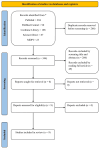Finerenone's Impact on Major Adverse Cardiovascular Events in Chronic Kidney Disease and Type 2 Diabetes Mellitus: A Systematic Review
- PMID: 39350809
- PMCID: PMC11440448
- DOI: 10.7759/cureus.68274
Finerenone's Impact on Major Adverse Cardiovascular Events in Chronic Kidney Disease and Type 2 Diabetes Mellitus: A Systematic Review
Abstract
Chronic kidney disease (CKD) impacts about 10% of adults globally and substantially elevates the risk of major adverse cardiovascular events (MACE), such as heart attacks, strokes, cardiovascular-related deaths, and hospital admissions due to heart failure. The interplay between CKD and cardiovascular disease (CVD) leads to poor health outcomes. Nevertheless, there is a scarcity of systematic reviews focusing on the effectiveness of finerenone, a new non-steroidal mineralocorticoid receptor antagonist (MRA), in lowering these risks. In this systematic review, we aim to evaluate the impact of finerenone on reducing MACE in individuals with CKD and type 2 diabetes mellitus (T2DM). CKD pathophysiology involves hyperglycemia, hypertension, and dyslipidemia, leading to glomerular hyperfiltration, inflammation, and fibrosis. Traditional treatments, including angiotensin-converting enzyme inhibitors (ACEi), angiotensin II receptor blockers (ARBs), and sodium-glucose cotransporter-2 inhibitors (SGLT2i), often fall short in preventing cardiovascular events. Steroidal MRAs like spironolactone and eplerenone, while effective in reducing proteinuria, are limited by hyperkalemia risks. Finerenone offers a more selective mechanism, reducing sodium retention, inflammation, and fibrosis, with a lower risk of hyperkalemia. We searched five electronic databases comprehensively, identifying studies consistently demonstrating that finerenone significantly reduces MACE and improves renal outcomes by reducing albuminuria and slowing the fall in estimated glomerular filtration rate (eGFR). However, limitations include study heterogeneity, short follow-up periods, and potential publication bias. In conclusion, finerenone shows promise as a therapeutic option for CKD and T2DM, reducing MACE and improving renal outcomes. Further research is needed to understand its long-term benefits and safety across diverse populations.
Keywords: chronic kidney disease (ckd); diabetes mellitus type 2; drug-induced hyperkalemia; estimated glomerular filtration rate (egfr); finerenone; major adverse cardiovascular events; mineralocorticoid receptor antagonist.
Copyright © 2024, Murugan et al.
Conflict of interest statement
Conflicts of interest: In compliance with the ICMJE uniform disclosure form, all authors declare the following: Payment/services info: All authors have declared that no financial support was received from any organization for the submitted work. Financial relationships: All authors have declared that they have no financial relationships at present or within the previous three years with any organizations that might have an interest in the submitted work. Other relationships: All authors have declared that there are no other relationships or activities that could appear to have influenced the submitted work.
Figures
References
-
- Effect of finerenone on chronic kidney disease outcomes in type 2 diabetes. Bakris GL, Agarwal R, Anker SD, et al. N Engl J Med. 2020;383:2219–2229. - PubMed
Publication types
LinkOut - more resources
Full Text Sources
Research Materials
Miscellaneous

